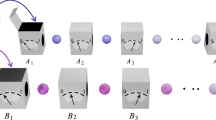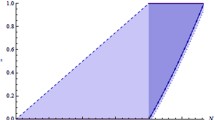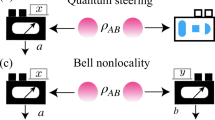Abstract
By employing Pauli measurements, we present some nonlinear steering criteria applicable for arbitrary two-qubit quantum systems and optimized ones for symmetric quantum states. These criteria provide sufficient conditions to witness steering, which can recover the previous elegant results for some well-known states. Compared with the existing linear steering criterion and entropic criterion, ours can certify more steerable states without selecting measurement settings or correlation weights, which can also be used to verify entanglement as all steerable quantum states are entangled.


Similar content being viewed by others
References
Einstein, A., Podolsky, B., Rosen, N.: Can it quantum mechanical description of physical reality be considered complete? Phys. Rev. 47(10), 777 (1935)
Schrödinger, E.: Probability relations between separated systems. Proc. Cambridge Philos. Soc. 32(3), 446 (1936)
Wiseman, H.M., Jones, S.J., Doherty, A.C.: Steering, Entanglement, Nonlocality, and the Einstein-Podolsky-Rosen Paradox. Phys. Rev. Lett. 98(14), 140402 (2007)
Reid, M.D.: Signifying quantum benchmarks for qubit teleportation and secure quantum communication using Einstein-Podolsky-Rosen steering inequalities. Phys. Rev. A 88(6), 062338 (2013)
He, Q., Rosales-Zárate, L., Adesso, G., Reid, M.D.: Secure Continuous Variable Teleportation and Einstein-Podolsky-Rosen Steering. Phys. Rev. Lett. 115(18), 180502 (2015)
Walk, N., Hosseini, S., Geng, J., Thearle, O., Haw, J.Y., Armstrong, S., Assad, S.M., Janousek, J., Ralph, T.C., Symul, T., Wiseman, H.M., Lam, P.K.: Experimental demonstration of Gaussian protocols for one-sided device-independent quantum key distribution. Optica 3(6), 634 (2016)
Kogias, I., Xiang, Y., He, Q., Adesso, G.: Unconditional security of entanglement-based continuous-variable quantum secret sharing. Phys. Rev. A 95(1), 012315 (2017)
Branciard, C., Cavalcanti, E.G., Walborn, S.P., Scarani, V., Wiseman, H.M.: One-sided device-independent quantum key distribution: Security, feasibility, and the connection with steering. Phys. Rev. A 85(1), 010301(R) (2012)
Piani, M., Watrous, J.: Necessary and Sufficient Quantum Information Characterization of Einstein-Podolsky-Rosen Steering. Phys. Rev. Lett. 114(6), 060404 (2015)
Horodecki, R., Horodecki, P., Horodecki, M., Horodecki, K.: Quantum entanglement. Rev. Mod. Phys. 81(2), 865 (2009)
Bell, J.S.: On the Einstein-Podolsky-Rosen Porodox. Physics 1, 195 (1964)
Jones, S.J., Wiseman, H.M., Doherty, A.C.: Entanglement, Einstein-Podolsky-Rosen correlations, Bell nonlocality, and steering. Phys. Rev. A 76(5), 052116 (2007)
Brunner, N., Cavalcanti, D., Pironio, S., Scarant, V., Wehner, S.: Bell nonlocality. Rev. Mod. Phys. 86(2), 419 (2014)
Bowles, J., Vértesi, T., Quintino, M.T., Brunner, N.: One-way Einstein-Podolsky-Rosen Steering. Phys. Rev. Lett. 112(20), 200402 (2014)
Händchen, V., Eberle, T., Steinlechner, S., Samblowski, A., Franz, T., Werner, R.F., Schnabel, R.: Observation of one-way Einstein-Podolsky-Rosen steering. Nature Photonics 6, 596 (2012)
Wollmann, S., Walk, N., Bennet, A.J., Wiseman, H.M., Pryde, G.J.: Observation of Genuine One-Way Einstein-Podolsky-Rosen Steering. Phys. Rev. Lett. 116(16), 160403 (2016)
Saunders, D.J., Jones, S.J., Wiseman, H.M., Pryde, G.J.: Experimental EPR-steering using Bell-local states. Nat. Phys. 6, 845 (2010)
Schneeloch, J., Broadbent, C.J., Walborn, S.P., Cavalcanti, E.G., Howell, J.C.: Einstein-Podolsky-Rosen steering inequalities from entropic uncertainty relations. Phys. Rev. A 87(6), 062103 (2013)
Ji, S.W., Lee, J., Park, J., Nha, H.: Steering criteria via covariance matrices of local observables in arbitrary-dimensional quantum systems. Phys. Rev. A 92(6), 062130 (2015)
Zhen, Y.Z., Zheng, Y.L., Cao, W.F., Li, L., Chen, Z.B., Liu, N.L., Chen, K.: Certifying Einstein-Podolsky-Rosen steering via the local uncertainty principle. Phys. Rev. A 93(1), 012108 (2016)
Zheng, Y.L., Zhen, Y.Z., Chen, Z.B., Liu, N.L., Chen, K., Pan, J.W.: Efficient linear criterion for witnessing Einstein-Podolsky-Rosen nonlocality under many-setting local measurements. Phys. Rev. A 95(1), 012142 (2017)
Zheng, Y.L., Zhen, Y.Z., Cao, W.F., Li, L., Chen, Z.B., Liu, N.L., Chen, K.: Optimized detection of steering via linear criteria for arbitrary-dimensional states. Phys. Rev. A 95(3), 032128 (2017)
Yu, S.X., Chen, Q., Zhang, C.J., Lai, C.H., Oh, C.H.: All Entangled Pure States Violate a Single Bell’s Inequality. Phys. Rev. Lett. 109(12), 120402 (2012)
Pearson, K.: The London, Edinburgh, and Dublin Philosophical Magazine and Journal of. Science 2, 559–572 (1901)
Hotelling, H.: Analysis of a complex of statistical variables into principal components. Journal of Educational Psychology 24(6), 417 (1933)
Jolliffe, I.T.: Principal Component Analysis. Series: Springer Series in Statistics, 2nd ed., Springer (2002)
Gross, D.J.: Symmetry in Physics: Wigner’s Legacy. Phys. Today 48(12), 46 (1995)
Vollbrecht, K.G.H., Werner, R.F.: Entanglement measures under symmetry. Phys. Rev. A 64(6), 062307 (2001)
Stockton, J.K., Geremia, J.M., Doherty, A.C., Mabuchi, H.: Characterizing the entanglement of symmetric many-particle spin-1/2 systems. Phys. Rev. A 67(2), 022112 (2003)
Táth, G., Gühne, O.: Entanglement and Permutational Symmetry. Phys. Rev. Lett. 102(7), 170503 (2009)
Werner, R.F.: Quantum states with Einstein-Podolsky-Rosen correlations admitting a hidden-variable model. Phys. Rev. A 40(8), 4277 (1989)
Gisin, N.: Hidden quantum nonlocality revealed by local filters. Phys. Lett. A 210(3), 151 (1996)
Acknowledgements
This work was supported by the National Natural Science Foundation of China (NSFC) under Grant No. 11947102, the Natural Science Foundation of Anhui Province under Grant Nos. 2008085MA16 and 2008085QA26, the Key Program of West Anhui University under Grant No. WXZR201819, and the Research Fund for high-level talents of West Anhui University under Grant No. WGKQ202001004.
Author information
Authors and Affiliations
Corresponding author
Additional information
Publisher's Note
Springer Nature remains neutral with regard to jurisdictional claims in published maps and institutional affiliations.
Appendix: Proof of the equation \(\sum _{k=1}^{9}\lambda _{k}=\sum _{i=1}^{3}\sum _{j=1}^{3}\delta ^{2}(\sigma _{i}\otimes \sigma _{j})\)
Appendix: Proof of the equation \(\sum _{k=1}^{9}\lambda _{k}=\sum _{i=1}^{3}\sum _{j=1}^{3}\delta ^{2}(\sigma _{i}\otimes \sigma _{j})\)
In order to prove the equation \(\sum _{k=1}^{9}\lambda _{k}=\sum _{i=1}^{3} \sum _{j=1}^{3}\delta ^{2}(\sigma _{i}\otimes \sigma _{j})\), we extend principal components analysis to quantum correlation matrix \(\gamma _{mm^{'}}(\rho _{AB})\) of local observables \(\{O_{m}\}=\{\sigma _{i}\otimes \sigma _{j}\} (i,j=1,2,3, m=3(i-1)+j)\). As in classical correlation analysis, the principal components on a matrix space can be expressed as
where \(j=1,2,...,9\). \(\sum _{i}a_{ij}^{*}a_{ij}=1\), and \(\sum _{i}a_{ij}^{*}a_{ik}=0\) for \(j\ne k\).
To achieve the first principal component, we use the Lagrange multiplier technique to find the maximum of a function. The Lagrangian function is defined as
where \(\lambda _{1}\) are the Lagrange multipliers. The necessary conditions for the maximum are
By using the properties of the trace, we obtain
By rearranging the above expression, we get
For \(i=1,...,9\), the following eigenvalue problem is obtained in compact form:
where \({{\varvec{a}}}_{1}=(a_{11},a_{21},...,a_{91})'\), \(\gamma _{ij}=(\langle O_{i}O_{j}\rangle +\langle O_{j}O_{i}\rangle )/2-\langle O_{i}\rangle \langle O_{j}\rangle \), which is exactly the quantum covariance matrix as defined in Eq.(6). It shows that \({{\varvec{a}}}_{1}\) should be chosen to be an eigenvector of the covariance matrix \(\gamma \), with eigenvalue \(\lambda _{1}\). The variance of the first principal component is
Therefore, in order to obtain the maximum of the variance, \({{\varvec{a}}}_{1}\) should be chosen as the eigenvector corresponding to the largest eigenvalue \(\lambda _{1}\) of the covariance matrix. Similarly, for the second principal component, in order to obtain the second maximum of the variance, \({{\varvec{a}}}_{2}\) should be chosen as the eigenvector corresponding to the second largest eigenvalue \(\lambda _{2}\) of the covariance matrix. This is fully consistent with the classical principal components analysis since the variances correspond to the eigenvalues of the covariance matrix.
For a arbitrary covariance matrix \(\gamma _{ij}(\rho _{AB})\) of local observables \(\{O_{m}\}=\{\sigma _{i}\otimes \sigma _{j}\} (i,j=1,2,3, m=3(i-1)+j)\), the variance of the observables \(O_{m}\) can be analytically given as \(\sum _{m=1}^{9}\delta ^{2}(O_{m})=\sum _{i=1}^{N}\delta ^{2}P_{i}\) due to the fact \(\sum _{j}a_{ij}^{*}a_{ij}=1\). As \(\sum _{i=1}^{N}\delta ^{2}P_{i}=\sum _{i=1}^{N}\lambda _{i}\), one achieves \(\sum _{m=1}^{9}\delta ^{2}(O_{m})=\sum _{i=1}^{9}\lambda _{i}\).
Rights and permissions
About this article
Cite this article
Pan, GZ., Yang, M., Yuan, H. et al. Nonlinear steering criteria for arbitrary two-qubit quantum systems. Quantum Inf Process 20, 48 (2021). https://doi.org/10.1007/s11128-020-02954-5
Received:
Accepted:
Published:
DOI: https://doi.org/10.1007/s11128-020-02954-5




